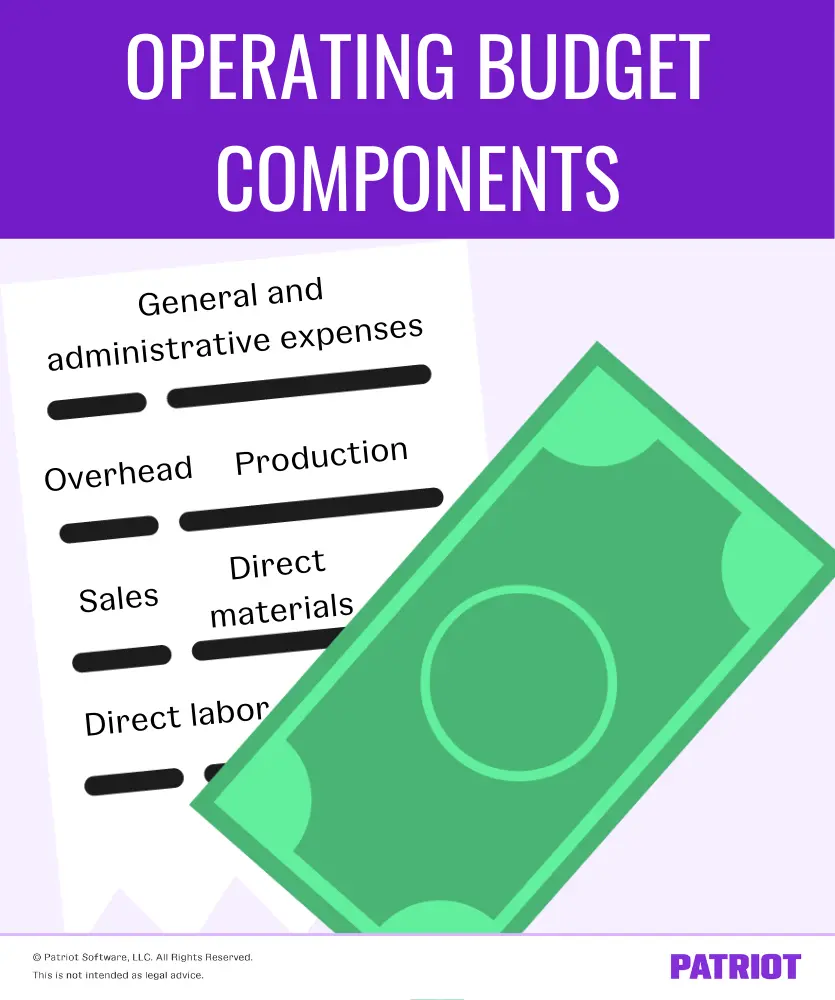There are a number of different types of business budgets. One kind of budget that your business may have is an operating budget. Read on to learn what is an operating budget and what to include in yours.
What is an operating budget?
An operating, or operational, budget outlines the funds you need to make your business run efficiently and successfully during a period. It consists of all revenues and expenses your company expects to use for its operations.
Operating budgets typically break down things like fixed and variable costs, revenue, and other expenses.
Like with a regular business budget, many businesses tend to create their new annual operating budget at year-end. That way, they can plan out their budget for the entire year and set financial goals. However, nothing is set in stone. A business may tweak its operating budget throughout the year (e.g., each month) to ensure it’s up-to-date with any operational changes.
Creating an operating budget can be beneficial for your small business. An operational budget can:
- Help you manage current expenses
- Project future expenses
- Reduce business debt
- Establish financial accountability
- Help your business stay on track
Operating budget components
Operating budgets can vary from business to business. Some businesses may need different or additional parts to their budget than others.
A number of other budgets make up your operating budget. Although they can vary, some of the main components of an operating budget include the following sections:
- Sales
- Production
- Direct materials
- Direct labor
- Overhead
- General and administrative expenses
Sales budget
Part of your operating budget is making a sales budget. Your sales budget lays out a projection of how many services and/or products your business will sell and how much revenue you’ll earn from those sales.
Projecting your business’s sales allows you to plan and make adjustments to your spending.
To create your sales budget, start by making a list of all of the products and services your company sells. Also include each of their price points. After you make your list, take a look at your previous year’s sales figures to project how many of each product/service you plan to sell each month in the upcoming year.
Keep in mind that things like the economy, pricing policies, and competitors can impact your sales budget. Think about these factors when creating your sales budget.
Production budget
Another component of an operating budget is the production budget. Your production budget tells you how many units of each product to produce to meet sales needs and inventory requirements.
Your product and sales budgets go hand-in-hand. Use your sales budget to help create your production budget (e.g., units you expect to sell during the year).
To put together an annual production budget, gather the following information:
- Expected number of units to be sold (based on last year’s data)
- Required level of ending inventory
- Number of units in your beginning inventory, if any
Calculate the number of units to produce for each product by using the formula below:
Units to Produce = Expected Unit Sales + Units in Ending Inventory – Units in Beginning Inventory
Use the formula to calculate the number of units your need to produce for each of your goods.
Your production budget also helps determine other aspects of your operating budget later on, including your direct materials, direct labor, and overhead budgets (which we’ll get to next).
Direct materials budget
After you create your sales and production budgets, it’s time to set a direct material budget. Your direct materials budget determines the number of units of raw materials your business needs to purchase for its production process. Raw materials may include things like steel, gasoline, lumber, or plastic.
The direct materials budget uses the number of units to be produced from your production budget. It also includes the required level of ending inventory for raw materials and the number of units in beginning inventory (if applicable).
A direct materials budget states the cost and amount of each type of raw material a business needs. Prepare a separate direct materials budget for each type of raw material.
Direct labor budget
After you establish your direct materials budget for the upcoming period, you need to create a direct labor budget. A direct labor budget shows the number of direct labor hours and cost of the labor to determine the total cost of direct labor.
The hours for direct labor are determined by the relationship between labor and output. You can find your units of direct labor by looking at components of your production budget (e.g., units to be produced).
To find the cost of direct labor for a period, take the number of units you plan on producing (from your production budget) and multiply it by the direct labor hours per unit (how long it takes to produce one unit). Then, take that total and multiply it by how much it costs you to produce a unit per hour (e.g., how much it costs in labor).
Total Direct Labor Hours = Units to Produce X Direct Labor Hours Per Unit
Cost of Direct Labor = Total Direct Labor Hours X Cost Per Hour
Overhead budget
Your overhead budget includes variable and fixed overhead costs for the year (or another period).
Variable costs can vary based on your sales activity (e.g., commissions and direct labor). For example, if sales are high, your variable costs increase. Your variable costs fluctuate month to month.
Fixed costs stay the same, regardless of your sales. They are the expenses you must pay to run your business (e.g., rent and insurance). Unlike variable costs, fixed costs typically stay the same each month.
List all of your variable and fixed overhead costs in your overhead budget section.
General and administrative expenses budget
Last but not least, include a general and administrative expenses section in your operating budget. This component includes the fixed and variable operating expenses for the general and administrative areas of your business.
Like with your overhead budget, detail your fixed and variable expenses for your general and administrative budget. Again, fixed expenses can include things like utilities and salaries, while variable expenses can be direct materials and sales commissions.
Include all of your general and administrative expenses for the year in this portion of your budget.

Operating budget example
Now that you know how to create an operating budget, let’s go through an example to see one in action.
For this example, we are going to keep things simple and look at an annual operating budget. Keep in mind that you can use whatever period you’d like when creating your business’s operational budget (e.g., quarterly, monthly, etc.).
Say your business sells hats. You expect to sell 5,000 hats (aka units) next year. You sell each hat for $30 each, making your total sales for the year $150,000 ($5,000 X $30). Your sales budget for next year would look similar to this:
| Annual Total | |
| Units | 5,000 |
| Selling Price | $30 |
| Total Sales | $150,000 |
For this example, let’s say you only sell one type of hat. Again, you expect to sell 5,000 hats/units next year (from your sales budget). Your required ending inventory is 200 hats and your beginning inventory is 500. Take a look at what your production budget will look like:
| Sales | 5,000 units |
| Required Ending Inventory | 200 units |
| Units Required (Sales + Ending Inventory) | 5,200 units |
| Beginning Inventory | 500 units |
| Units to Produce (Units Required – Beginning Inventory) | 4,700 units |
Based on the production budget above, you need to produce 4,700 during the year.
Next, let’s look at your direct materials budget. Based on your production budget, you have 4,700 units to produce next year. You need two pieces of fabric to make each hat. Your cost per unit is $1.00. You do not have a required ending inventory. However, you do have a beginning inventory of 1,000 units of fabric.
Take a look at how to break down your direct materials budget:
| Units to Produce | 4,700 |
| Fabric Per Unit | 2 |
| Required Ending Inventory | 0 |
| Total Units Required (Units to Produce X Fabric Per Unit + Required Ending Inventory) | 9,400 |
| Beginning Inventory | 1,000 |
| Units to Purchase (Total Units Required – Beginning Inventory) | 8,400 |
| Cost Per Unit | $1 |
| Cost of Raw Materials | $8,400 |
For your direct labor budget, it takes three hours of labor to create one hat, and each labor hour costs $12. Your cost for direct labor is $28,200. Here’s how your direct labor budget for the year would look:
| Units to Produce | 4,700 |
| Direct Labor Hours Per Unit | 0.5 |
| Total Direct Labor Hours (Units to Produce X Direct Labor Hours Per Unit) | 2,350 |
| Cost Per Labor Hour | $12 |
| Cost of Direct Labor (Total Direct Labor Hours X Cost Per Labor Hour) | $28,200 |
Again, your overhead budget includes both fixed and variable costs. You have both fixed and variable costs in this example. Check out what your overhead budget portion of your operating budget would look like:
| Variable Costs | |
| Maintenance | $2,000 |
| Total Variable Costs | $2,000 |
| Fixed Costs | |
| Rent | $12,000 |
| Insurance | $1,800 |
| Total Fixed Costs | $13,800 |
| Total Overhead Costs (Total Variable Costs + Total Fixed Costs) | $15,800 |
| Total Direct Labor Hours | 2,350 |
| Overhead Rate (Total Overhead Costs / Total Direct Labor Hours) | $6.72 |
For your general and administrative expenses budget, you also have some fixed and variable expenses. Here’s what that would look like:
| Variable Expenses | |
| None | $0 |
| Fixed Expenses | |
| Office Supplies | $1,000 |
| Utilities | $1,800 |
| Total General and Administrative Expenses | $2,800 |
You have a budget of $2,800 for your general and administrative expenses.
Are you on track with your operating budget? Patriot’s online accounting software helps you record transactions and keep your books up-to-date. Plus, we offer free, USA-based support. What are you waiting for? Try it for free today!
This is not intended as legal advice; for more information, please click here.



